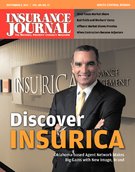The Arkansas Supreme Court has denied an insurer’s appeal of a lower court finding that the language of its insurance policy in a case involving an underinsured driver is ambiguous.
Philadelphia Indemnity Insurance Co. was the insurer for Focus Inc., a non-profit entity serving disabled children and adults. In May 2009 a bus driven by a Focus employee and carrying passengers served by Focus was involved in a collision with another vehicle. Several passengers were killed and others seriously injured. The driver of the other vehicle, who was found to be at fault, had a liability policy with 21st Century Insurance.
“The policy had a property-damage limit of $25,000 per accident and bodily-injury coverage that provided a limit of $50,000 in the aggregate,” Justice John N. Fogleman explained in delivering the opinion of the Court. “Because most of the subsequent claims exceeded [the driver’s] policy limits, [his] vehicle was underinsured for the damages.” Focus’s policy included underinsured motorist coverage with an alleged damage limit of $1 million, Fogleman wrote.Philadelphia Insurance acknowledged a duty to pay the $1 million for the underinsured motorist coverage but maintained it had no further liability beyond that amount.
The insured passengers and the estates of those killed filed a counter claim against Philadelphia, asserting that “Focus negligently failed to restrict its driver … from using her cell phone while driving the bus.” They contended there was an additional $1 million in liability coverage in the business auto declaration of Focus’s liability policy.
Philadelphia Insurance maintained, however, that it was a combined single limit (CSL) policy and filed a motion to dismiss.The Craighead County Circuit Court denied the motion, finding the policy to be ambiguous.
At “issue is whether the insurance policy, which reflects liability coverage of ‘$1 million CSL’ and underinsured-motorist coverage of ‘$1 million CSL,’ provides an aggregate coverage of $2 million or a coverage limited solely to $1 million,” Fogleman wrote.
The policy’s declarations page contained a “Schedule of Coverages and Covered Autos,” Fogleman noted. “That schedule of coverage provides that the liability coverage contains a limit of $1 million while the underinsured-motorist coverage also contains a limit of $1 million. The initials ‘CSL’ are designated beside each $1 million amount in the limit columns for both liability and underinsured-motorist coverage,” according to Fogleman.
The CSL term, he said, “is not defined in the 248-page policy, nor is it found anywhere else in the policy other than the ‘Schedule of Coverages and Covered Autos.'”
Fogleman also noted that an affidavit submitted by a senior vice president for Philadelphia Insurance stated “the policy was a CSL policy and referenced a dictionary of insurance terms that defined CSL as combining the limits of bodily injury liability and property-damage liability.” The definition did not contain an underinsured motorist coverage provision. Therefore, the circuit court was free to reject the CSL definition in the affidavit, Fogleman wrote.
Philadelphia also argued that sections in the policy state that if two or more of its policies issued to the same insured apply to the same “‘accident’ the aggregate maximum Limit of Insurance under all the Coverage Forms or policies shall not exceed the highest applicable Limit of Insurance under any one Coverage Form or policy.”
The Court rejected Philadelphia’s assertion that the business auto liability coverage and the underinsured motorist coverage were provided under two separate policies. It pointed to the fact that “the liability coverage and underinsured-motorist coverage are nevertheless under the same coverage form,” adding that only a single policy number was listed in the case under review.
Topics Carriers Auto Personal Auto Alaska
Was this article valuable?
Here are more articles you may enjoy.


 Personal Auto Insurers Have Edge on Innovation: AM Best
Personal Auto Insurers Have Edge on Innovation: AM Best  Fannie and Freddie Hit Pause on Replacement-Value Requirements for Home Insurance
Fannie and Freddie Hit Pause on Replacement-Value Requirements for Home Insurance  Reserve Strengthening for Casualty Lines Not Over: Moody’s
Reserve Strengthening for Casualty Lines Not Over: Moody’s  Berkshire’s ‘Most Important’ Biz Drives Q1 Results; GEICO Still Behind on Tech
Berkshire’s ‘Most Important’ Biz Drives Q1 Results; GEICO Still Behind on Tech 


